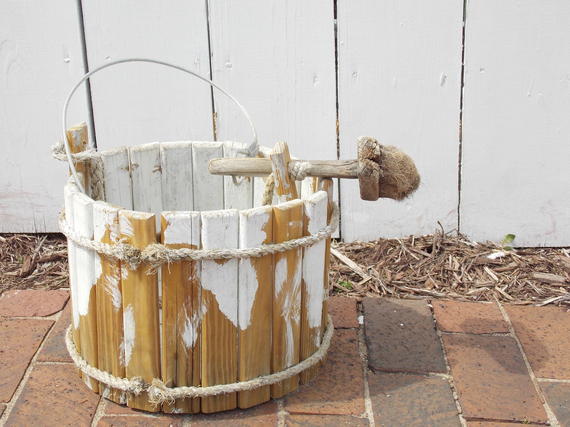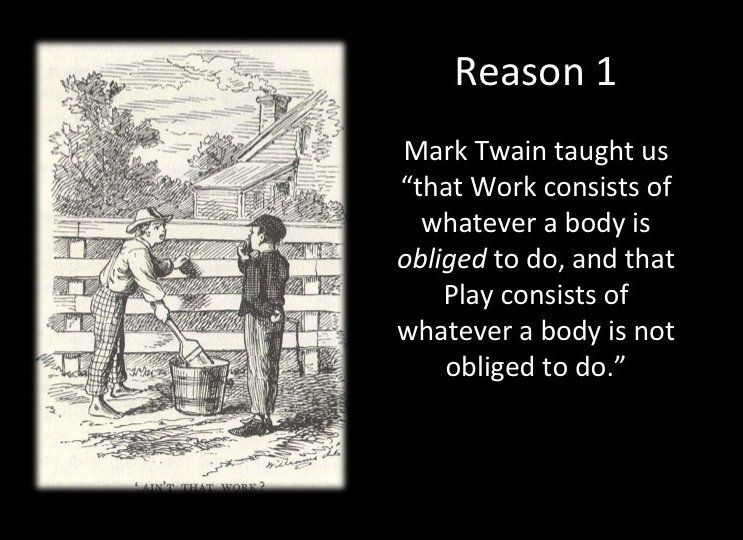He had had a nice, good, idle time all the while -- plenty of company -- and the fence had three coats of whitewash on it! If he hadn't run out of whitewash, he would have bankrupted every boy in the village. -- Mark Twain, The Adventures of Tom Sawyer (1876)
When was the last time you reenacted a scene from The Adventures of Tom Sawyer? More to the point, when was the last time you whitewashed a fence -- or, better yet -- paid for the privilege?
If walking in Tom Sawyer's shoes (bare feet?) has been your fantasy since childhood, you're in luck. On Thursday, July 3, 2014 at 1:00 pm I'll be in Hannibal, Missouri in front of Mark Twain's -- make that Samuel Langhorne Clemens's -- boyhood home. I'll be whitewashing the world's most famous fence. If your travels are taking you to the midwest for the Fourth of July festivities, I could use a little help in Hannibal. It's the 59th Annual National Tom Sawyer Days, after all.
Last year at this time, I challenged Henry Sweets, my friend and counterpart at the Mark Twain Boyhood Home & Museum, to a friendly wager. The Hannibal museum and the Mark Twain House and Museum in Hartford, Connecticut, both non-profit entities, lack sufficient endowment funds to ensure preservation of the homes. The homes are not officially affiliated, but in the Twain world, we collaborate as much as possible. So, from time to time, we dabble in the Tom Sawyer approach to getting things done. This wager was one such approach. I lost the bet, and therefore I'll be whitewashing. And I'll happily swap the opportunity to whitewash for a cash donation to be shared equally between the two Twain homes.
Both museum homes depend on their "dollar at the door" initiative to benefit their respective endowments. Chances are, if you've purchased a ticket to tour either home in recent times, a friendly staff member asked if you would also like to donate one dollar to the museum's endowment fund. (To all those who have, and speaking on behalf of both museums, thank you!) These dollars are the only funds donated to either endowment fund on a regular and ongoing basis. Both museums' endowments are woefully underfunded: Hannibal's at $1.6 million, Hartford's at $1.5 million. Therefore, this little dollar at the door is an important campaign for anyone who believes Mark Twain's homes should be preserved for future generations.
During the 31 days of July in 2013, Hartford and Hannibal staff competed to see which home could raise more money per ticket sold, and when the month ended and the figures were tabulated, Hannibal emerged victorious by a nose. Abe Lincoln's nose, to be precise. They raised $2,190.70 and sold 6,207 tickets ($0.35 per ticket sold). Hartford raised $2,207.70 and sold 6,473 tickets ($0.34 per ticket sold). Hannibal won fair and square, and I didn't know whether to be happy or sad that we only lost by a penny on the ticket. Had Hannibal lost, Henry Sweets would be heading to Hartford to wash the first floor windows at 351 Farmington Avenue.
IMPORTANCE OF ENDOWMENTS
An endowment is an investment, or a portfolio of investments, owned by a non-profit entity. Its principal is never spent. Instead, the yield from the investment is spent each year toward preservation, upkeep, and daily operations. It is standard operating procedure for museums and other non-profits to use the yield each year for general operating support without ever spending the actual investment.
I've assigned myself the job of making sure people know about the endowment needs of the Mark Twain homes and asking them to contribute what they can. As the former director in Hannibal (October 2008-February 2013), I launched "dollar at the door" there, but I also took a creative approach to generating endowment funds with Mark Twain: Words & Music, a double-CD that tells Mark Twain's story in spoken word and song. Generous artists such as Jimmy Buffett, Sheryl Crow, Emmylou Harris, Vince Gill, Garrison Keillor, Clint Eastwood, Rhonda Vincent, Joe Diffie, Marty Raybon, Carl Jackson, Brad Paisley, and others stepped forward. Every CD purchase generates revenue for Hannibal's endowment, whether you buy it there, in Hartford, or elsewhere.
HOMES SAVED
Generous benefactors saved both homes from destruction years ago: Hannibal's George Mahan saved the boyhood home in 1912. Katharine Seymour Day organized a group of supporters to save Mark Twain's Hartford house in 1929. Day also saved the home next door, which belonged to her great-aunt, Harriet Beecher Stowe. As Stowe's grandniece, Day took an important extra step and bequeathed funds -- an endowment -- to benefit the Stowe House. Today the Stowe endowment stands at $16 million, a much more realistic figure to care for a 19th century property. A similar endowment is the goal of both the Mark Twain Boyhood Home & Museum in Hannibal and the Mark Twain House & Museum in Hartford.
Mark Twain fans should be grateful to these two visionaries, Mahan and Day, for recognizing Mark Twain's importance to the world. It is to their credit that today we can tour the actual houses instead of seeing a marker that reads:
"Here stood the home of Mark Twain -- America's Greatest Author"
THE FUTURE
But these same fans (you know who you are, Twainiacs!) also need to understand the difference between "operations" and "endowment" -- something I learned while volunteering at the Boyhood Home several years ago. Memberships, admission fees, grants, sponsorships, and museum store proceeds support operations. This revenue helps keep the doors open for visitors, supports educational programs, and pays for cleaning, maintenance, utilities, insurance, and general upkeep -- during a good year. An endowment, on the other hand, is derived solely from donations and bequests and is never spent. It is invested, and proceeds from the investment become part of that operating budget. An endowment provides security for a non-profit. If a roof needs replaced (and it will at some point), there's no need to sell off the other assets to pay for it. In the case of both Mark Twain homes, the expense to preserve old buildings and conserve artifacts always exceeds operating income -- hence the struggle to reach an endowment capable of sustaining operations, especially during a bad year.
The Hannibal boyhood home complex is comprised of nine properties -- eight buildings, including the home where Sam Clemens lived from 1839 to 1853, plus the statue of Tom & Huck at the foot of Cardiff Hill. The Hartford home, built by Sam and Olivia Clemens 140 years ago and recently named "one of the ten best historic homes in the world" by National Geographic's Ten Best of Everything Book, includes the family's carriage house and museum center.
I've loved Mark Twain since Mr. Riese introduced him to our fourth-grade class all those years ago. He has remained my favorite author since childhood. When I grew up and discovered there were TWO Twain houses I could visit, I couldn't believe it. I was in my thirties before I finally got to visit Hartford, and I visited Hannibal for the first time the year I turned forty. No matter how often I step inside either home, I'm struck by the magnitude of their significance. In one home, Sam Clemens experienced the adventures and antics he would later immortalize. In the other home, he remembered those adventures and wrote about them upstairs in his third-floor billiard room. These two homes are inextricably bound. They share a singular mission, to preserve the legacy of America's most beloved ambassador. They could use some help -- and another coat of whitewash.


